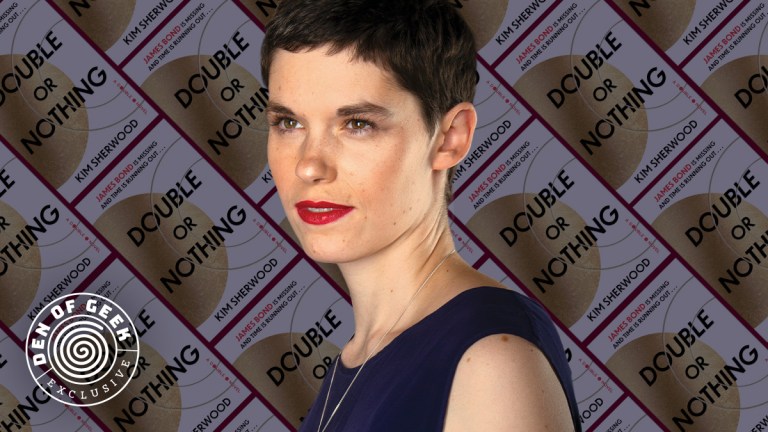How Kim Sherwood Wrote a Killer James Bond Novel Without Bond
Exclusive: Kim Sherwood introduces new Double Os to care about in James Bond novel Double or Nothing.

This article appears in the new issue of DEN OF GEEK magazine. Get your copy here.
For the Ian Fleming Estate to pass the baton of writing 007 novels from Anthony Horowitz to Kim Sherwood, it took a stellar proposal with just enough heart, thanks to child Kim’s magazine-clipping-scrapbook report on Fleming. With Double or Nothing, she introduces new Double Os to care about: doctor Johanna Harwood (003) and chess prodigy Sid Bashir (009), locked in a love triangle with the MIA Bond; and ex-soldier Joseph Dryden (004), linked to quantum computer Q, as they outwit a billionaire holding the world hostage. Sherwood’s hands-on research had her racing in the Alpine A110 S sports car, exploring the Barbican in London, and bringing Bond into the 21st century.
We talked to Sherwood about all things MI6 for the latest issue of Den of Geek magazine:
How did you balance writing in the style and spirit of Ian Fleming while avoiding pastiche?
It’s a challenge because obviously, I can’t write like Ian Fleming, I can only write like myself. Because I have admired him for so long, he influenced my writing, the approach I took was: Where are there shared points of commonality or shared DNA between our styles? He has these uncanny, unsettling images; he often likens the human body to an animal or meat or something mechanical. Particularly when things are going wrong for Bond—in Casino Royale, at first, the imagery is very beautiful, very lulling in the setting, and as Bond starts to lose, things get creepier. Another way was he uses this third-person omniscient point of view that’s almost like a roving camera; you can enter into anybody’s mind. That was my approach, looking to Fleming for my cues but then trying to write in my own style.
Double or Nothing has love triangles within honeypots, with the Double Os using seduction to track each other’s loyalties. How did you decide upon romantic intrigues to drive the plot?
It was very much at the beginning of the process, thinking about writing, in essence, a James Bond novel that doesn’t star James Bond. I thought of him like a star with his own gravity; if he’s there, you’re going to look at him. So I’ll bake that metafictionally into the plot and have it that he’s missing from the beginning. But then you’re asking the reader to care about these other characters they don’t know. So, I’ll use Bond’s gravity: One of the Double Os will be someone who Bond has mentored (Bashir), one of them will be his ex-lover (Harwood), and then if I have a love triangle between the three, that’s a fantastic engine for the conflict that can drive the plot forward. And we know that all three love each other, so we have that reason to care about them.
Did you have a particular Bond in mind when writing his flashbacks?
It would change depending on the scene. I’m writing in Fleming’s world, but you can’t ignore the films, nor would I want to, because he himself was influenced by that process. But particularly action scenes, I’m thinking of Daniel Craig’s brawn and muscularity; I’d be thinking of Sean Connery’s sort of panther-like walk or Pierce Brosnan’s suave, smooth charm.
You’re the first woman to write a Bond novel and the second woman to write within the larger universe (after Kate Westbrook’s The Moneypenny Diaries). How did that add to the pressure?
I thought a lot about the legacy of women in Bond. I had a lot to live up to, going back to the real Johanna Harwood [and 003 namesake] co-writing Dr. No and From Russia with Love—it’s my favorite Bond film—and all of the amazing actresses who have been such an integral part of the franchise; Barbara Broccoli really helming the films. Also, the Fleming Estate is headed up by a woman, so I felt like I didn’t want to let the side down. But when I was a kid playing imaginary games of James Bond, I would pretend I was James Bond; I didn’t pretend I was a Bond girl. That’s no criticism of Bond girls, but I didn’t want to be rescued; I wanted to be doing the rescuing. So this felt like an opportunity, as a female author and as a female fan of Bond, to have a female Double O, to put Moneypenny in charge, to bring main female characters onto the page.
If you could give each new agent their own Bond theme song, what would it be?
“Nobody Does It Better” for Harwood and Bond because [it’s] a beautiful love song, but it’s also a very sad love song that fits their slightly thwarted love for each other. The big, bombastic “Skyfall” would be most obvious for Dryden because I was writing such massive [set pieces], everything going off bang. For Bashir and Harwood’s relationship, since they’re playing a cat-and-mouse game, one of the songs that just really is about sex: “Diamonds Are Forever.”
What can we expect from the rest of the trilogy?
One of the things that has interested me about the writing process is looking at how formally experimental Fleming was. So, the books will follow different structures; in some of them, Bond doesn’t come in until very late, like On Her Majesty’s Secret Service or From Russia, with Love, so he really wasn’t afraid to play with his formula. And that I found encouraging because Book 2 carries on from Book 1 certainly story-wise, but there were new elements I wanted to take on and things I hadn’t had a chance to do in Book 1. So that was nice to almost have Fleming’s permission to play a bit more in the sandbox.
Double or Nothing will be published by William Morrow on April 11.
